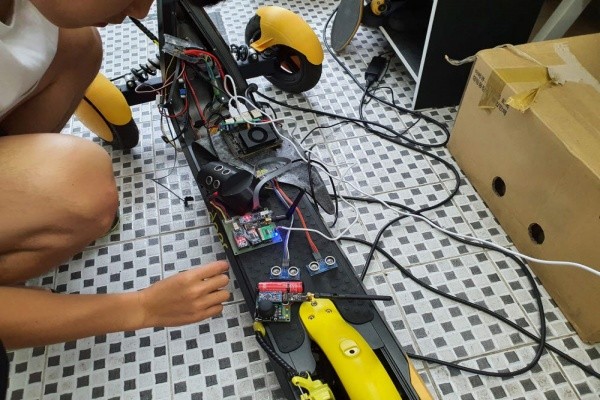A South Korean startup has developed an autonomous electric scooter that returns to a location designated by a service provider on its own after its user is done with it. It can also be placed at a location on its own. These technologies are seen as solutions to the parking issue that is seen as the biggest headache for scooter rental providers. Autonomous electric scooters will also help rental providers with profitability as they do not require manpower to relocate scooters.
According to the industry, a South Korean shared scooter startup called DEER Corporation has succeeded in developing an electric scooter prototype applied with autonomous driving technology. There has yet to be any case of autonomous e-scooter development anywhere in the world. Although an American company called Curiosity Lab introduced its “Go X” project on YouTube prior to DEER Corporation’s development, it has not been confirmed whether the company actually developed such e-scooter with teleoperated repositioning technology. Another South Korean startup PUMP, which manages a scooter sharing service called Xingxing, has been working on e-scooter along with an autonomous driving software (SW) developer called Neubility since June.
Autonomous e-scooter does not require expensive equipment or advanced technologies like autonomous vehicles because it focuses on collection and placement rather than transportation of people or objects. It is able to achieve a goal at a low speed as it does not have a person riding on it and it is also relatively easy to avoid accidents with autonomous e-scooters.
Instead of an expensive “LIDAR (Light Detection and Ranging)” sensor, DEER Corporation utilized “depth camera” that is relatively inexpensive. Depth camera recognizes surroundings in 3D by sensing depths of objects. E-scooter with 3D depth camera is able to establish a highly accurate map by mapping surroundings while it is on the move. Based on an accurate map that it establishes in advance, it is able to understand current location through its depth camera and move autonomously. This concept is similar to the “visual SLAM” technology that is generally used in autonomous robots.

DEER Corporation’s autonomous e-scooter is able to place and collect autonomously within a 500 meters diameter. Because it just needs to go to a designated location within individual area, it does not require a long-distance autonomous driving technology. It is designed with a machine learning algorithm that orders it to reverse or perform evasion steering once it senses cars or people. It alerts nearby people so that they do not become surprised of it. By developing a corresponding autonomous driving technology, DEER Corporation earned the top prize from Seoul National University’s contest on creative comprehensive design this year.
Deer’s prototype is designed with two wheels in the front so that it does not fall easily compared to other e-scooters. However, it will require a person or people if it falls down. DEER still needs to accumulate more knowhow in order for individuals to call its autonomous e-scooters through their smartphones.
“Although autonomous e-scooters do not require advanced technologies as autonomous vehicles, it is difficult to understand the industry without actually starting a shared e-scooter business.” said Kang Jae-yoon who is the CTO of DEER. “Autonomous e-scooters will be very useful for the South Korean market especially as it is highly crowded in major cities.”
Autonomous e-scooters also greatly reduce “non-service hours”. Because e-scooters that are placed in spots that are outside of service areas are just left there until they are picked up, they can negatively affect shared e-scooter providers greatly. If they can be replaced after having them come back autonomously and charging them, one’s profitability is expected to jump by five to ten times.
DEER is planning to commercialize an autonomous e-scooter in the first half next year based on its prototype.
“We are planning to conduct field tests with dozens of autonomous e-scooters by utilizing the government’s regulatory sandbox system and push for mass-production depending on results related to their stability.” said Park Sang-woo who is the head of product development at DEER. “We are also going to improve our profitability at the same time by reducing the manufacturing cost an autonomous e-scooter below $860 (100 million KRW).”
Staff Reporter Lee, Hyeongdu | dudu@etnews.com